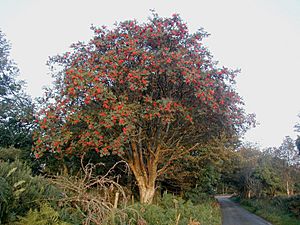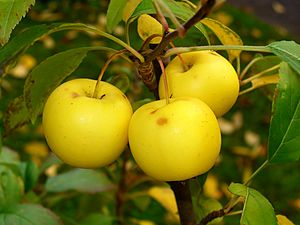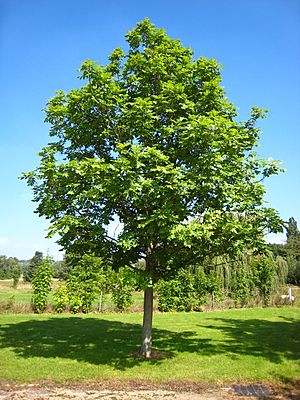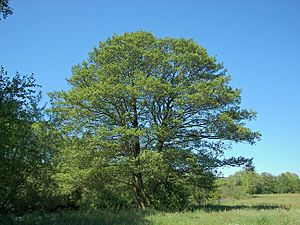List of trees of Great Britain and Ireland facts for kids
Trees are amazing plants that grow tall and strong. In Great Britain and Ireland, you can find many different kinds of trees. But figuring out exactly which trees count as "native" (meaning they've always been here) or even what counts as a "tree" can be a bit tricky! This article will help you learn about the trees that call these islands home.

Contents
What Makes a Tree a Tree?
It might seem simple, but even scientists sometimes disagree on what exactly makes a plant a tree!
How We Define a Tree
Usually, a tree is a big, woody plant that lives for many years. It has one main stem, called a trunk, and branches that grow from it. This is different from a shrub, which often has many stems growing from the ground. Most experts agree that a plant needs to grow at least 6 meters (about 20 feet) tall to be called a tree.
What is a Species?
When we talk about different types of trees, we use the word "species." A species is a group of living things that can reproduce together. But sometimes, it's hard to tell if two plants are truly different species or just variations of the same one. For example, some trees, like rowans, whitebeams, elms, and willows, have many types that look very similar. Some might even be natural hybrids, which means they are a mix of two different species.
What Does "Native" Mean for Trees?
A "native" tree is one that has grown in a place naturally for a very long time. For Britain and Ireland, this usually means trees that have been here since the end of the last Ice Age. That was when the ice melted and trees started to grow back.
Some trees arrived after the English Channel formed, separating Britain from mainland Europe. Other trees might have arrived later without human help. It can be hard to know for sure! Many trees have been brought to Britain and Ireland by people over hundreds of years. Some of these "introduced" trees have now started to spread on their own. We call these "naturalised" trees.
A very special type of native tree is an "endemic" species. This means the tree is found naturally only in Britain and Ireland, nowhere else in the world! Most of our endemic trees are types of whitebeams.
Native Trees of Britain and Ireland
These are some of the trees that have been growing naturally in Great Britain and Ireland for thousands of years.


- Alders
- Alder (Alnus glutinosa)
- Apples
- Crab Apple (Malus sylvestris)
- Ashes
- Common Ash (Fraxinus excelsior)
- Beeches
- European Beech (Fagus sylvatica)
- Birches
- Silver Birch (Betula pendula)
- Downy Birch (Betula pubescens)
- Box
- Box (Buxus sempervirens)
- Cherries and Plums
- Wild Cherry (Prunus avium)
- Bird Cherry (Prunus padus)
- Blackthorn (Prunus spinosa)
- Elms
- Wych Elm (Ulmus glabra)
- Field Elm (Ulmus minor) - This one has many different types!
- Hawthorns
- Common Hawthorn (Crataegus monogyna)
- Midland Hawthorn (Crataegus laevigata) - Found mostly in southern Great Britain.
- Crataegus × media - A natural mix of the two hawthorn types.
- Hazels
- Common Hazel (Corylus avellana)
- Hollies
- European Holly (Ilex aquifolium)
- Hornbeams
- European Hornbeam (Carpinus betulus) - Found mostly in southern Great Britain.
- Junipers
- Common Juniper (Juniperus communis)
- Lindens (Limes)
- Small-leaved Linden/Lime (Tilia cordata)
- Large-leaved Linden/Lime (Tilia platyphyllos) - Found mostly in southern Great Britain.
- Maples
- Field Maple (Acer campestre)
- Oaks
- Pedunculate Oak (Quercus robur)
- Sessile Oak (Quercus petraea)
- Pines
- Scots Pine (Pinus sylvestris)
- Poplars
- Aspen (Populus tremula)
- Black Poplar (Populus nigra) - Found mostly in southern Great Britain.
- Rowans and Whitebeams
- European Rowan (Sorbus aucuparia)
- Common Whitebeam (Sorbus aria) - And several similar types.
- Service Tree (Sorbus domestica) - Recently found growing wild in south Wales.
- Wild Service Tree (Sorbus torminalis)
- Strawberry Tree
- Strawberry Tree (Arbutus unedo) - Found only in Ireland.
- Willows (Salix species) - There are several types!
- Bay Willow (Salix pentandra)
- Grey Willow (Salix cinerea)
- Goat Willow (Salix caprea)
- Purple Willow (Salix purpurea)
- Yews
- European Yew (Taxus baccata)
Native Large Shrubs
These plants are usually shrubs, but sometimes they can grow big enough to be called trees!
- Alder Buckthorn (Frangula alnus)
- Purging Buckthorn (Rhamnus cathartica)
- Elder (Sambucus nigra)
- Common Dogwood (Cornus sanguinea)
- Rock Whitebeam (Sorbus rupicola)
- (Common) Sea-buckthorn (Hippophae rhamnoides)
- Spindle (Euonymus europaeus)
- Eared Willow (Salix aurita)
- Guelder Rose (Viburnum opulus)
- Wayfaring tree (Viburnum lantana)
- Common Privet (Ligustrum vulgare)
Naturalised Trees
These trees were brought to Britain and Ireland by people, but now they grow and spread on their own, just like native trees.
From Europe
- Maritime Pine (Pinus pinaster) - Rare.
- European Black Pine (Pinus nigra) - Rare.
- Norway Spruce (Picea abies) - Rare.
- European Larch (Larix decidua)
- European Pear (Pyrus communis) - Some people think this might be native.
- Plymouth Pear (Pyrus cordata) - Some people think this might be native.
- Cherry Plum (Prunus cerasifera)
- Sycamore (Acer pseudoplatanus)
- Norway Maple (Acer platanoides)
- Sweet Chestnut (Castanea sativa) - Brought by the Romans!
- Swedish Whitebeam (Sorbus intermedia)
- Holm Oak (Quercus ilex)
- Turkey Oak (Quercus cerris)
- Common Horse-chestnut (Aesculus hippocastanum)
- English Elm (Ulmus procera) - Also brought by the Romans!
- Osier (Salix viminalis)
- Crack Willow (Salix fragilis)
- White Willow (Salix alba)
- Almond-leaved Willow (Salix triandra)
From Asia
- Japanese Larch (Larix kaempferi)
From North America
- Lodgepole Pine (Pinus contorta)
- Sitka Spruce (Picea sitchensis)
- Black Spruce (Picea mariana) - Rare.
- Douglas-fir (Pseudotsuga menziesii)
- Grand Fir (Abies grandis)
- Western Hemlock (Tsuga heterophylla)
- Western Redcedar (Thuja plicata)
- Lawson's Cypress (Chamaecyparis lawsoniana)
- Monterey Cypress (Cupressus macrocarpa) - Rare.
From Oceania
- Cabbage palm (Cordyline australis)
Endemic Trees
An endemic species is a plant that grows naturally only in one specific area. Britain and Ireland have a few special trees that are found nowhere else in the world! Most of these are types of Whitebeam.
- Plot's Elm – Found only in the English Midlands.
- Apomictic Whitebeams - These are special types of whitebeams that are unique to the British Isles:
- Sorbus arranensis – Only on the Isle of Arran.
- Arran Service Tree – Only on the Isle of Arran.
- Sorbus pseudomeinichii - Only on the Isle of Arran.
- Lancashire Whitebeam - Only around Morecambe Bay in North Lancashire and South Cumbria.
- English Whitebeam - Found in Great Britain and Ireland.
- Bristol Whitebeam - Only in the Avon Gorge.
- Devon Whitebeam – Found in Devon, Somerset, Cornwall and Ireland.
- Ley's Whitebeam – Only in the Brecon Beacons.
- Lesser Whitebeam – Only in the Brecon Beacons.
- Sorbus leptophylla – Unique to the UK.
- Sorbus arvonensis - Only in the Menai Strait area of North Wales.
- Sorbus wilmottiana – Unique to the UK.
- Bloody Whitebeam – Only in Exmoor.
- Somerset Whitebeam – Only on the coast of North Devon and Western Somerset.
- Cheddar Whitebeam – Only in Cheddar Gorge.
- No Parking Whitebeam – Only in North Devon.
- Llangollen Whitebeam – Only in Llangollen.
- Irish Whitebeam – Only in Ireland.
- Leigh Woods Whitebeam, Only in Leigh Woods.
Learn More About Trees
- Trees of the world
- Woodland management
- Coppicing
- Pollarding
- Forestry in the United Kingdom
- British National Vegetation Classification
- List of forests in Ireland
- List of forests in the United Kingdom
- Coillte


